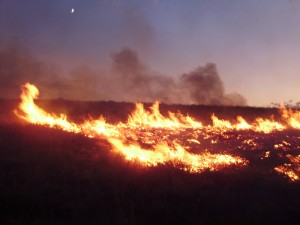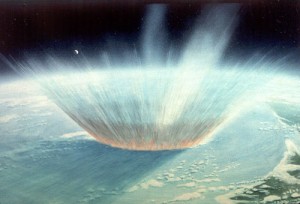23 December 2015
Large asteroid hit would make the world burn, go dark
Posted by Lauren Lipuma
by Alison F. Takemura

The Chicxulub impact caused worldwide fires, sending quadrillions of kilograms of soot into the atmosphere. That soot today would plunge the world into total darkness for two years, according to new research.
Credit: Famartin via Wikimedia Commons
Sixty-six million years ago, an asteroid crashed into Earth. Its impact, scientists believe, caused global catastrophic fires, transformed the climate, and caused the extinction of the dinosaurs. A new study shows that if a similar asteroid were to strike Earth today, the soot from fires alone would severely alter the climate and imperil life.
“A world with this big of an [asteroid] impact is a world you wouldn’t want to live in,” said Charles Bardeen, an atmospheric scientist of the University of Colorado at Boulder and lead author of the study.
The asteroid that killed off the dinosaurs and formed the Chicxulub crater in Mexico created havoc for the planet, according to scientists. Ten kilometers (six miles) across, the asteroid sent up clouds of dust and flying red-hot rocks around the globe. Flung almost into orbit, the rocks landed everywhere, sparking fires that set the world ablaze. The asteroid’s impact also vaporized rocks that released greenhouse gases and triggered massive volcanic eruptions in modern-day India. Traces of those eruptions linger today, in the form of basalt layers called the Deccan Traps.
All these effects would have shifted the climate. But Bardeen and his colleagues have found that the global conflagration’s soot, rising into the atmosphere, may have been cataclysmic on its own.
Using a climate model that captures the whole atmosphere, the team simulated the effect of 70,000 teragrams of soot — the amount that blanketed the earth after the Chicxulub impact — on today’s climate.
The soot would have life-threatening effects, Bardeen reported at the 2015 American Geophysical Union Fall Meeting. According to Bardeen’s model, the soot would blot out sunlight for two years, halting photosynthesis. By three years after the impact, the land surface would have cooled by twice the amount that would send the planet into an ice age. In the same time period, the ocean would have chilled by 10 degrees Celsius. The world would also become much drier: for six years, rain and snowfall would drop to 20 percent of normal levels.
Scientists still debate the extent to which the volcanic eruptions and other effects of the Chicxulub impact altered the ancient climate and endangered life. But the damage the soot would cause to the modern planet is so extensive in the model, the volcanoes may not have mattered much, said Alan Robock, a climatologist at Rutgers University in New York who was not involved in the study.
To investigate the effects the dinosaurs would have seen, Bardeen will next be modeling a Chicxulub impact with the position of the continents at the time the asteroid actually struck. Ocean circulation was different then, and would have affected how the climate responded, he said.
The researchers plan to check these model results against the fossil record. Finding organisms that could survive in these conditions, Bardeen said, would bolster the idea that soot strongly influenced the climate. On the other hand, if fossils contradict the model predictions, then other factors — such as submicron dust from the asteroid impact, carbon dioxide from fires, or sulfur dioxide, both from the impact and volcanoes — could have played larger roles in extinguishing most of life on Earth, he said.
– Alison Takemura is a science communication graduate student at UC Santa Cruz. You can follow her on twitter @AlisonTakemura.




 GeoSpace is a blog on Earth and space science, managed by AGU’s Public Information staff. The blog features posts by AGU writers and guest contributors on all sorts of relevant science topics, but with a focus on new research and geo and space sciences-related stories that are currently in the news.
GeoSpace is a blog on Earth and space science, managed by AGU’s Public Information staff. The blog features posts by AGU writers and guest contributors on all sorts of relevant science topics, but with a focus on new research and geo and space sciences-related stories that are currently in the news.